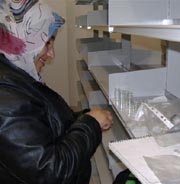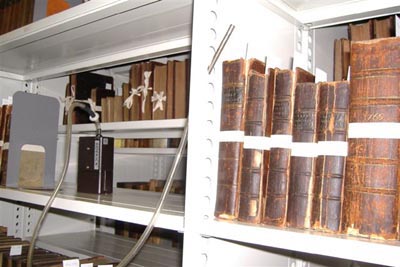Visitors being shown around Special Collections often remark on the distinctive and evocative aroma of old books. We are currently collaborating with a research team based at the University of Strathclyde who are investigating what causes these smells.
The heritage smells project team are trying to capture the chemical components of the “smell”. It is hoped that their findings will help inform us about possible deterioration of the material in books (to indicate whether preservation treatment may be required, for example) or whether the emissions are in any way harmful. Further investigation may lead to identifying degraded books by their smell, or even extract information about why the books degraded.
We have had a number of devices placed in our book stack that draw through the air and test the VOCs (volatile organic compounds) of the surrounding area. We have also selected a number of “smelly” books from different dates and in varying states of degradation that are being tested by the insertion of a very small piece of elastomer that will absorb any gases or chemical being emitted by the volumes; the idea is to establish whether or not the VOCs which are produced by the textblock and binding can be related and compared to the visual condition of the book.
Many of our books have been “treated” chemically in the past, and we are particularly pleased to be investigating a 17th century manuscript herbal that is currently not available for consulation: it contains over 850 plant samples, gathered from Leiden botanical garden in 1678. It was treated with DDT (dichloro diphenyl trichloroethane) many years ago to prevent insect infestation of the specimens. Until now, we have not known how much potentially dangerous chemical residue still remains in the book. The poisonous by-products of DDT do not readily decompose and can remain in the environment for long periods and, therefore, we have been unable to let researchers consult it. We hope that testing will establish the extent of the residue, and give us a much better idea of how we can proceed with future conservation treatment that will ultimately allow access to it again.
We are looking forward to finding out more – who nose what the results will be!
Categories: Library, Special Collections


 Johnny Beattie: ‘The Clown Prince of Scotland’
Johnny Beattie: ‘The Clown Prince of Scotland’  Visualizing Collation in the Hunterian Manuscript Collection
Visualizing Collation in the Hunterian Manuscript Collection  ASC Rewind: The expression of the emotions in man and animals
ASC Rewind: The expression of the emotions in man and animals  ASC Rewind: Apocalypse
ASC Rewind: Apocalypse
Wow, interesting!
Sounds a really interesting project. (Though the romantic in me feels, like a child not wanting to lose faith in Santa, that a scientific explanation for “that smell” might detract from the mystique!)